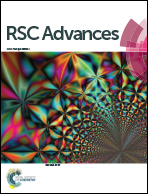Solution-processed efficient deep-blue fluorescent organic light-emitting diodes based on novel 9,10-diphenyl-anthracene derivatives†
Abstract
A series of 9,10-diphenyl-anthracene derivatives bearing either benzimidazole or carbazole moieties as substituents were synthesized and characterized as blue emitters for organic light-emitting diodes (OLEDs). Their optical, electrochemical and thermal properties have been investigated, and their molecular structure–property relationships were evaluated. These compounds both exhibited a high glass-transition temperature (Tg ≥ 195 °C) and a high decomposition temperature (Td ≥ 494 °C). The solution processed non-doped device using CAC as a fluorescence emitter showed a maximum luminance efficiency of 1.63 cd A−1, a maximum power efficiency of 0.77 lm W−1 and a maximum external quantum efficiency of 1.53%. By introducing 1,3-bis[4-tert-butylphenyl-1,3,4-oxadiazolyl] phenylene (OXD-7):polyvinylcarbazole (PVK) as host in the emitting layer, the doped deep-blue emitting device of CAC exhibited a turn-on voltage of 4.75 V, a maximum luminance efficiency of 3.03 cd A−1, a maximum power efficiency of 1.64 lm W−1 and a maximum external quantum efficiency of 2.81%. Our results demonstrate a promising approach to well-designed materials for use in deep-blue fluorescence OLED applications.


 Please wait while we load your content...
Please wait while we load your content...